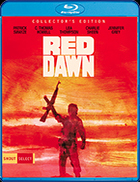Red Dawn (1984)
|  Note: Significant portions of this review have been adapted from my 2009 book Hollywood Bloodshed: Violence in 1980s American Cinema. John Milius’s Red Dawn is a war movie constantly at war with itself. It is an often compelling and always entertaining, but fundamentally flawed merging of Hollywood’s Reagan-era penchant for action escapism and distinct Cold War paranoia. Its deep, internal divisiveness derives from the fact that it began as one kind of film—a psychologically driven, anti-war parable—but was eventually changed into something different—a rousing, action-oriented, anticommunist fantasy—while maintaining residual traces of what it was originally intended to be. Some scenes play as rabble-rousing jingoist blather, while others maintain a distinctly darker, more unsettling edge. At its best it is a poignant reminder how war robs the young of their youth, and its worst it feels like base propaganda. The script was originally written by Kevin Reynolds (Hatfields & McCoys, Waterwold) when he was a student at USC in the late 1970s. Then titled Ten Soldiers, it took place in a near-distant future and told the story of a group of young American high school students in Colorado who barely escape a surprise invasion by taking refuge in the mountains, where they eventually develop into guerrilla fighters who resist the foreign invaders. The story had a dark, antiwar edge that did not celebrate the students’ heroism so much as it questioned the slippery moral slope on which they stood. Similar to William Golding’s 1954 novel The Lord of the Flies (which also takes place during a near-future World War III), the story centered on how the strongest members of the group take control and assert their authority, and one of its overriding thematic threads is how power can be abused. That was not the film that was eventually made, however. By the time Ten Soldiers went into production in 1983 under the new title Red Dawn, at the behest of MGM/UA CEO Frank Yablans, the script had been significantly retooled by Milius, whose rightwing ideological inclinations and emphasis on action were clearly at odds with the antiwar message in Reynolds’s original script. Although routinely grouped with other director-auteurs of the New Hollywood “Film Generation” because he was a student at USC in the same class that produced George Lucas and John Carpenter, Milius was a militant archconservative, an avid gun collector who stood out among his more liberal associates. His biggest directorial success was Conan the Barbarian (1982), which had first gained Arnold Schwarzenegger worldwide exposure as an action star. Under Milius’s direction, Red Dawn changed from being a psychologically driven antiwar story to a “pure action movie,” one that was deeply infused with Reagan-era anticommunism and a celebration of patriotic violence. Milius’s first work in Hollywood in the early 1970s had been associated with the strain of reactionary films that reimagined the Western hero as a lone vigilante surrounded by rampant crime in a crumbling American society that was the legacy of the liberal ’60s. He did uncredited screenplay work on Dirty Harry (1971) and cowrote its sequel, Magnum Force (1983), and that experience with heroic vigilantism is apparent in his work on Red Dawn. Milius kept Reynolds’s scenario largely intact, opening in the same manner with an idyllic fall morning at the high school in the tiny town of Calumet, Colorado, being violently disrupted by invading Soviet, Cuban, and Nicaraguan soldiers parachuting from the sky and then opening fire on anyone in their sights (the first victim being a well-meaning history teacher whose opening lecture about the battle tactics of the Huns rhetorically sets the stage for the brutality to come). A group of teenagers led by Jed (Patrick Swayze), a recently graduated quarterback-hero, and his younger brother Matt (Charlie Sheen), manage to escape the carnage and make their way into the mountains, where they have spent much of their lives hunting and camping with their father (Harry Dean Stanton). Other members of the group include Danny (Brad Savage) and Aradvark (Doug Toby), the youngest and most naïve; Robert (C. Thomas Howell), who is driven into a particularly dark place by the execution of his father; and Daryl (Darren Dalton), the class president and mayor’s son. They are later joined by two teen girls, Erica (Lea Thompson) and Toni (Jennifer Grey), both of whom have clearly been traumatized and were being hidden by their uncle, a local rancher named Mr. Mason (Ben Johnson), and Lt. Col. Andrew Tanner (Powers Boothe), a Navy pilot who was shot down (which gives him one of the film’s best lines: “It was five to one. I got four.”). The cast is, like Francis Ford Coppola’s The Outsiders (1983), a veritable rundown of up-and-coming young Hollywood actors, many of whom had appeared in the Coppola film the previous year (Swayze, Howell, and Dalton) and several of whom would work together again (most famously, Swayze and Jennifer Grey in 1987’s romantic hit Dirty Dancing). Charlie Sheen, whose brother Emilio Estevez had also appeared in The Outsiders and whose father, Martin Sheen, had starred in the Milius-penned Apocalypse Now (1979), was making his auspicious screen debut, while Lea Thompson was coming off of notable supporting roles in Jaws 3-D (1983) and All the Right Moves (1983) and was about to enter into another level of stardom with her central role in Back to the Future (1985). Even with all the changes that Milius added to Reynolds’s original script, he kept certain thematic and emotional vestiges of the darker material, even allowed for elements of disturbing complexity, such as the depiction of some of the teenagers turning on each other and the sympathetic portrayal of a Cuban general (Ron O’Neal) who identifies with them because of his own past as a guerilla fighter. However, the overall message the film proclaims is the mythical, regenerative power of violence—the might of right, so to speak. The band of teenage guerilla fighters is like a collective vigilante, a lone force fighting against oppressive communist invaders who round up American citizens, put them in internment camps, and either “re-educate” them or ruthlessly slaughter them. The “criminals” against whom they fight are given a new, more globalized face in the invading Soviet, Cuban, and Nicaraguan soldiers, which formed a triumvirate of foreign nations most demonized by the Reagan administration in the ’80s. While the first two nations were viewed as the primary bastions of communism in the world, Nicaragua was widely blamed for terrorism throughout Central America. The vision of bucolic Midwestern America overrun with Eastern Bloc and Latin American forces was a potent image at the height of Reagan’s re-escalated Cold War standoff with communist nations—in some ways more visceral, if significantly less likely, than the fear of nuclear holocaust (which does play a role here, as we learn later that parts of the country, including Washington, DC, have been taken out by nukes). In that spirit, Milius made the violence in Red Dawn graphic and relentless and added substantially to the firepower depicted in the battles (it was the first film to be released with the then-newly created PG-13 rating, and had it been released a few months earlier it surely would have been rated R without some trims). The guerilla fighting envisioned by Reynolds as a path to the corruption of the innocent gave way to flag-waving, full-scale battles between the American teenagers and the invading soldiers, which is amplified by the militaristic score by Basil Poledouris, who came to specialize in composing for big action films (his other credits include Conan the Barbarian, 1986’s Iron Eagle, 1987’s RoboCop, and 1990’s The Hunt for Red October). In fact, the film’s narrative arc can be traced along the line of the teens’ increasingly powerful weapons, going from hunting knives, shotguns, and bows and arrows, to AK-47s, landmines, and grenade launchers. Thus, the violence in Red Dawn was packaged as one aspect of a conservative fantasy that played on and then placated Cold War audience fears by imagining an awful, just barely plausible scenario and then supplying a rousing solution. The trauma of invasion is easily remedied by the subsequent rise of American determination via the teenage rebels. Further, the film simultaneously refutes and underscores American power, thus assuaging guilt: By making the United States the victim of invasion, the film shows that the nation is always vulnerable, thus we must continue to maintain a vigorous watch (which is hardly surprising given that Alexander Haig, Ronald Reagan’s “I-am-in-control” top aide, was brought in to consult on the film). On the other hand, the film shows that even such an invasion would not be enough to kill the American spirit, which here becomes all-encompassing by appropriating the fighting style associated with U.S. enemies, namely the Viet Cong and Latin American and Middle Eastern terrorists. While it was largely vilified by critics at the time, Red Dawn had a healthy box office take of $38 million at the end of the summer season, which, according to Milius, made it the film that “saved MGM that year.” Since then, it has gained a substantial following on home video and cable television, developing a significant legacy, particularly because the viewers most attracted to it are adolescent boys who now consider it to be part of their childhood experience. While not as markedly associated with gung-ho Reaganite filmmaking as Rambo: First Blood Part II (1985), Red Dawn has seeped into the popular culture mindset as an example of either fervently patriotic or frighteningly reactionary entertainment, depending on your perspective.
Copyright © 2018 James Kendrick Thoughts? E-mail James Kendrick All images copyright © MGM / Shout! Factory | |||||||||||||||||||||||||||||||
Overall Rating: 

 (2.5)
(2.5)


